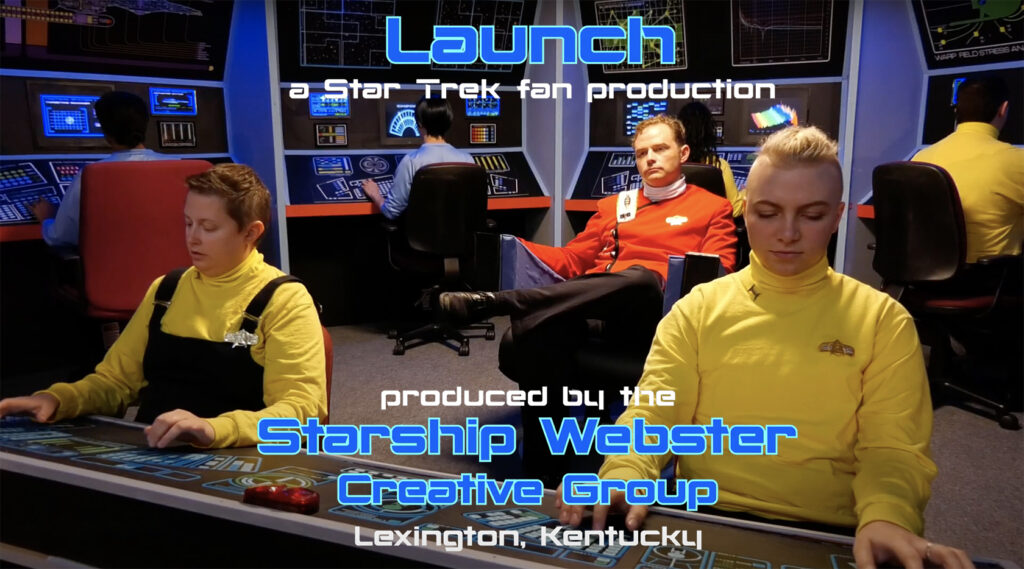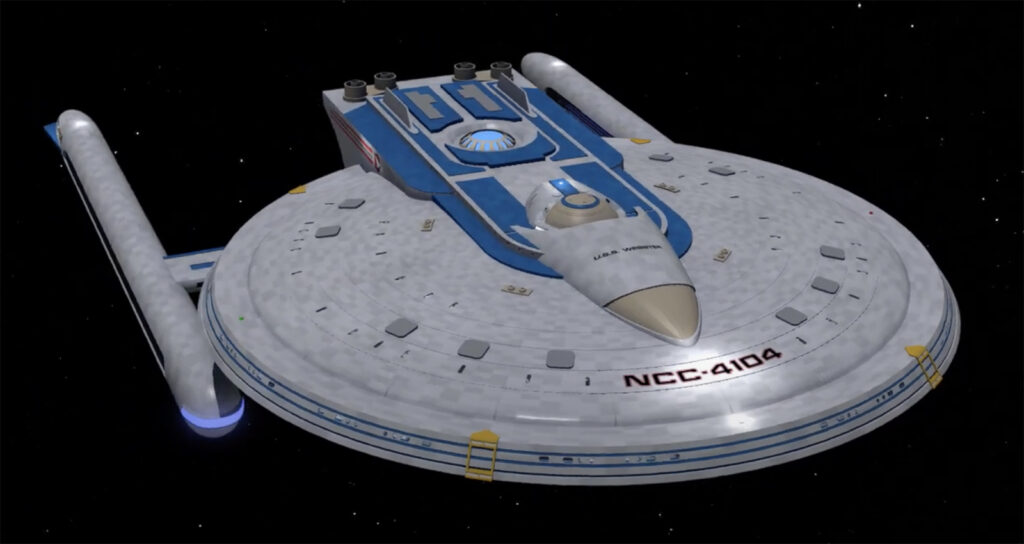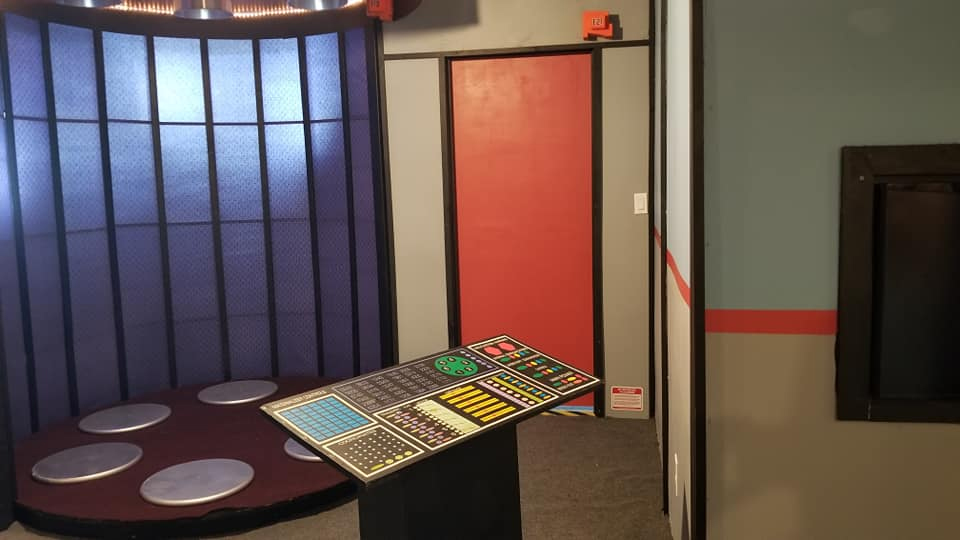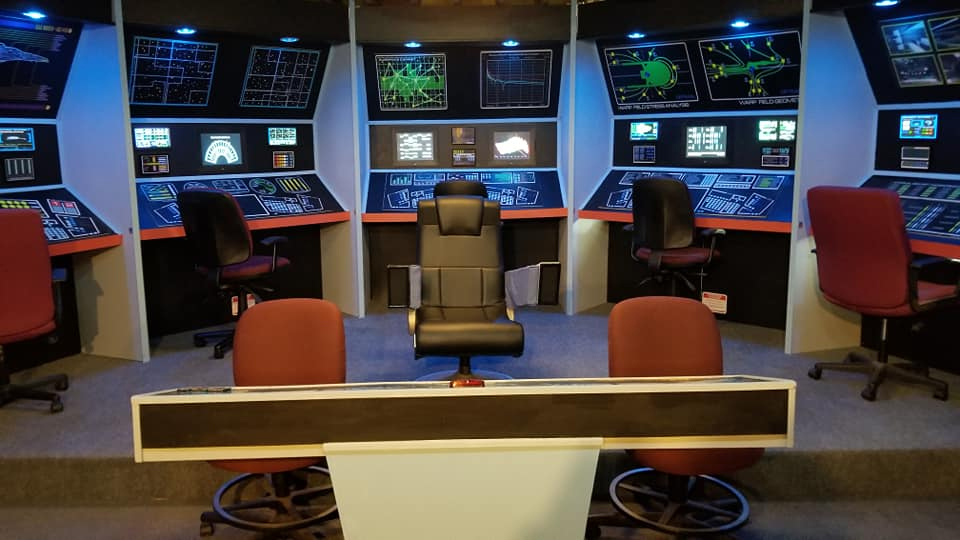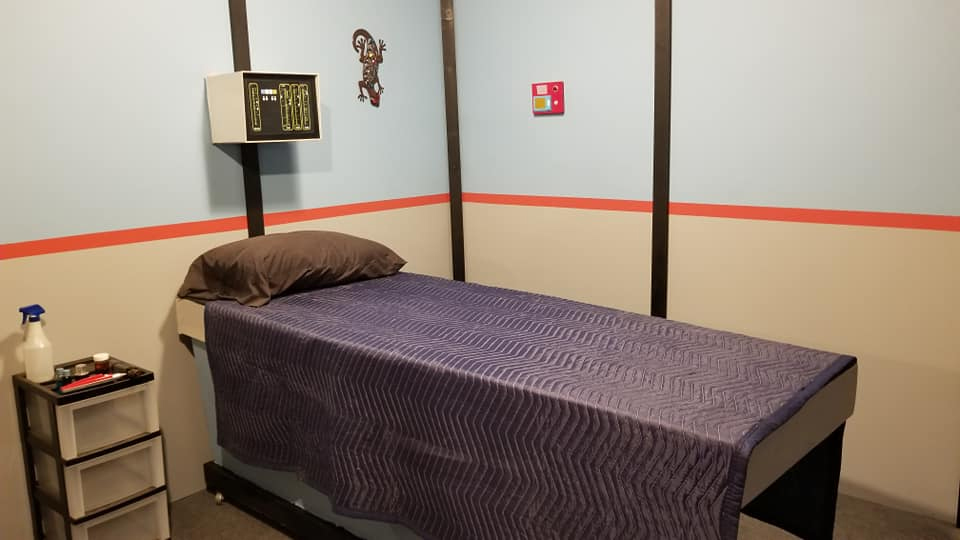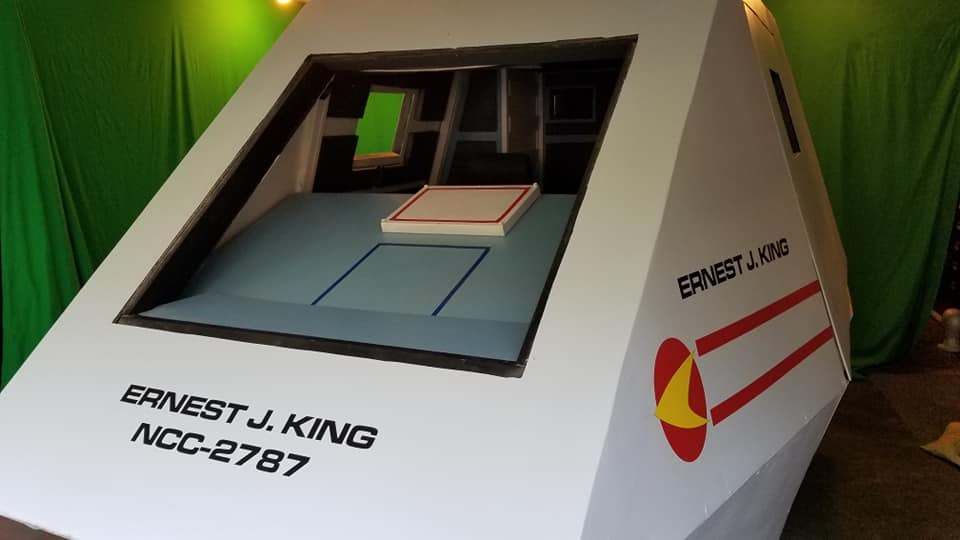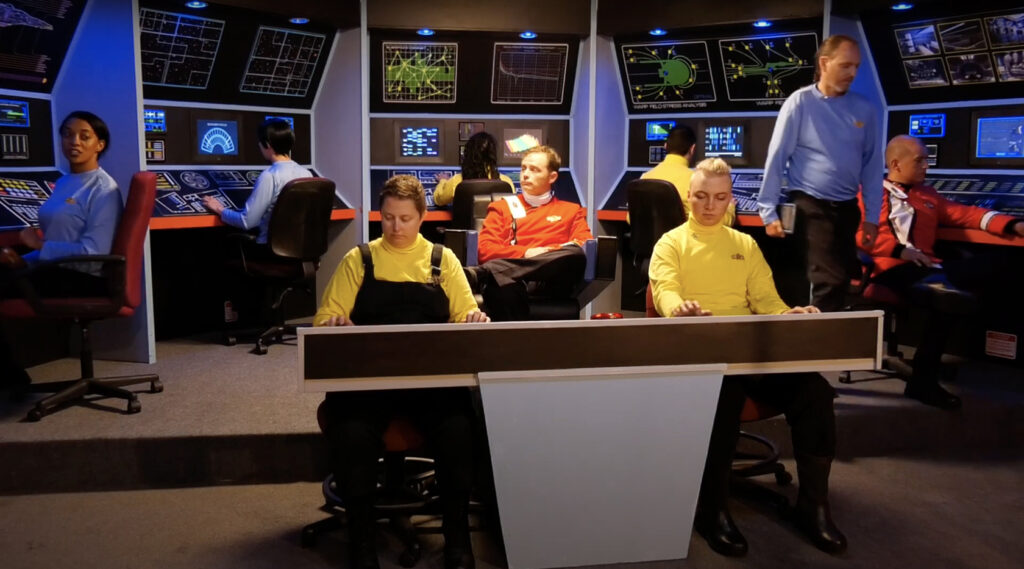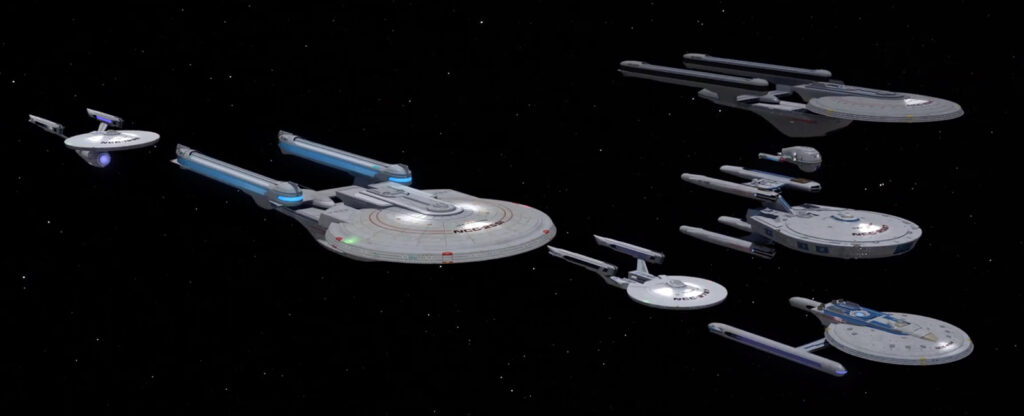Look out, pardner, ’cause there’s a new Trek fan series in town! But don’t you dare call it a “series”—’cause those pesky guidelines don’t like us doing series. So instead, let’s call it what POTEMKIN PICTURES calls it: the STARSHIP WEBSTER Creative Group.
This newest gang of fan filmmakers takes its place beside the other seven current Potemkin creative groups—including DEIMOS, ALEXANDER, TRISTAN, MARIE CURIE, BATTLECRUISER KUPOK, TRITON, and ENDEAVOUR…releasing (prior to the pandemic) an average of a dozen combined fan films each year going back more than half a decade! (You can access all of the previous Potemkin Pictures releases by clicking here.)
The various Potemkin Pictures productions have seen three bases of operations over the past ten-plus years. Things began in Albany, GA with their first fan series (back when you were allowed to call it that), PROJECT: POTEMKIN. When show-runner RANDY LANDERS moved to Alabama, some of the production team stayed in Georgia while others migrated to Alabama and various new creative groups formed.
Then, last year, Randy and his wife moved again, this time to Lexington, KY. This has allowed a whole new assemblage of fan filmmakers—writers, directors, producers, actors, make-up and costuming people, set builders, etc.—to join in on the fun in a brand new location. But there were certain unanswered questions.
- Would Randy be able to find enough local fans and actors to support a full creative croup?
- Would all the sets survive the 425-mile “trek” from Alabama to Kentucky and then be able to be properly rebuilt/reassembled?
- How long would it take to get their first fan film completed, and what would the new starship be called?
- What effect would the pandemic have on production?
- With the sets all located in a new state—6 and a half hours’ drive away from the previous location—would the other creative groups be willing or able to continue making their fan films?
Obviously, it’s time to talk to Randy Landers again! First, though, take a look at the premiere episode from the Starship Webster Creative Group, “Launch”…
JONATHAN – Welcome back, stranger. Haven’t had you around these parts for a full interview in a while!
RANDY – It has been a while, hasn’t it!
JONATHAN – Well, that’s partly because you keep suggesting that I interview your fellow creative group filmmakers instead of you…you modest guy, you! But this time, I need to go straight to the source. Let’s start with the move to Lexington. I’m assuming you needed to find a new house large enough to hold all of those elaborate sets. How did that unfold?
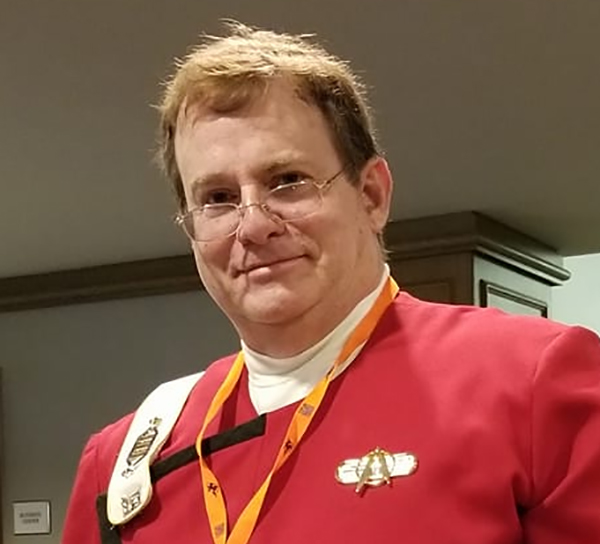
RANDY – When it became clear that we were going to relocate to Lexington, I had both my daughter Kim and my daughter-in-law Chelsea find me a house suitable for Linda, as well as having a space suitable for Potemkin Pictures. Using Zillow, they selected several, but the one they recommended highly was the one we saw first. And after viewing four others, it was clearly the best for both Linda’s and my needs.
We tended a very reasonable offer, and it was quickly accepted. Linda and I paid a relocation company to move the studio from “Space Center Storage” here in Lexington, where it had sat for a couple of months. She and I then moved a lot of the lumber, the shuttlecoupe, and the surviving set pieces ourselves.
JONATHAN – And now that you and your wife were settled in Lexington and your stuff was out of storage, how did you go about finding and connecting with local fans in your new area?
RANDY – So here we were with boxes of monitors, props, costumes…plus a huge shuttlecoupe and set pieces in various states of disrepair. I reached out to the local fans here in Lexington through Facebook’s marketing—it was a very reasonable price. I announced a meeting at a nearby library, we had more than a dozen people attend, and most all of them became the creative group.
JONATHAN – Well, that was easy! So what happened next?
RANDY – After I got the Creative Group together, we met at my residence, and I showed them the space we had for the facility. I also showed them the plans I had for the studio, and we discussed the name and the starship class for it.
JONATHAN – Did you come up with other possible names than Webster? And which Webster is it supposed to be?
RANDY – A number of names were considered: Lincoln, Bowie, Franklin, Clay. But the name the cast ended up choosing was the Delia Webster, named for the “petticoat abolitionist” here in Kentucky (a painting of Delia and her sisters hangs at the state capitol in Frankfort).
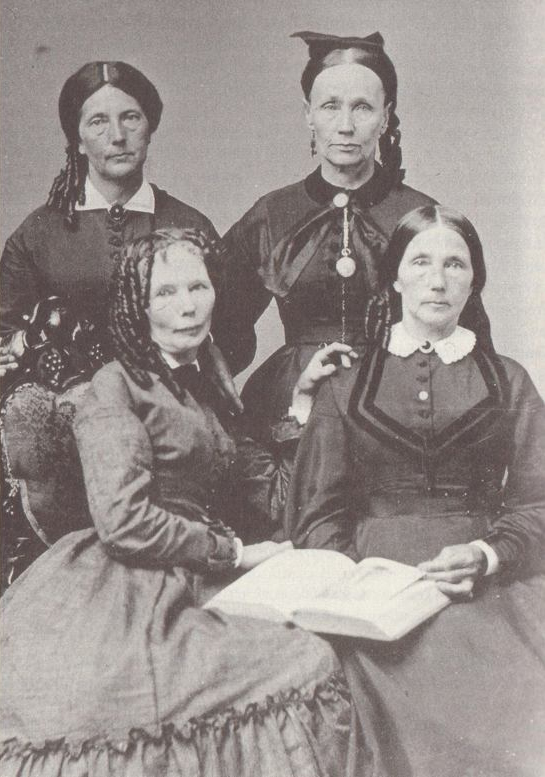
We considered a variety of starship classes (including the Miranda without the torpedo rollbar, the Winchester, and the Cheyenne), but we settled upon the Centaur class, which is basically a kitbash of the Excelsior class.
Once that was done, each cast member was assigned the task of creating their own character (name, rank, position) and we continued the search for additional cast. Knowing I wanted to do a proof-of-concept test film, I wrote “Launch” and invited the cast to submit scripts and story ideas to me. Meanwhile, we continued working on the sets. And that’s when COVID-19 hit.
Once the COVID quarantine hit, construction and decor was left to just me. Rather than sit around doing nothing, I spent nine weeks finishing those sets. And they look fantastic. I still had some down time, and seeing we had left over room, I constructed a three-walled transporter set using the background we had built at Studio 2 and used at Studio 3. Linda gave me a hand from time to time on that construction since the alcove has a ceiling.
JONATHAN – Tell us more about (re)designing and (re)building the sets. Which sets did you build, and what is different now in Kentucky than what was previously in Alabama?
RANDY – Great question. In Alabama, we had the bridge, the transporter room, the Klingon bridge, sickbay, officer’s quarters, a green screen room, and a partially completed shuttlecoupe. I sat down and practiced designing the bridge. I wanted a much bigger one than we had in Pelham, Alabama, and I wanted it at least as big as the one in the 2000 sq. ft. studio in Albany, Georgia.
We had the astrogator from the very first bridge we’d built on the carport (Studio 1), a sickbay bed from the 2000 sq. ft. warehouse (Studio 2), the transporter background from Studio 2, the briefing room chairs, and the “table.” That gave us a solid means of figuring out where to lay them out here in Lexington, KY at what we named Studio 4. So I chose to do standing sets for Sickbay, the briefing room, the bridge.
We had a wonderful work day where we framed and covered the walls, where we built the bridge deck, and then built communications upon which we measured and built the other four stations. The next work day, a month later, we built and painted the four remaining station frames, we painted the sickbay walls, and stained the briefing room walls. The next workday, we built a corridor door, then a bridge door.
This bridge set is roughly 20′ wide and 16′ deep, so it’s the largest bridge set we’ve constructed. After all the parts were assembled, it’s only a whopping three inches off from the original plans. Sickbay and the briefing room are both corner sets with only two walls each. At Studio 3, sickbay was an enclosed set with four walls and a door that made filming challenging.
The briefing room used to be literally on the green screen, so we’re delighted with the changes there. The front of the bridge is literally a hanging green screen that we attach with clamps, so taking it down to film is very easy. The turbolift on the port side (screen right) is a half-size affair with its own lighting and wheels, so it can be moved for convenience in filming.
After that, I turned my attention on finishing up the Shuttlecoupe we’d built at Studio 3. We had used it in Starship Deimos’ “Blood Crystals,” and I worked very hard giving it the finishing touches the Ernest J. King (a Deimos shuttle) deserved.
What we lost in the move was the standing Klingon bridge set. We still have the set pieces, though, but we will have to build some backgrounds for the bridge to be filmable. We also lost the quaint little officers’ quarters. No great lost there, I’m afraid. And we sold the futon to a nice couple when we moved here.
JONATHAN – How did you handle filming “Launch” during the pandemic? What did you do to keep everyone and everything safe?
RANDY – Our protocols are very safe. Masks are required. We limit the number of those present at the shoot to cast and crew only—no visitors to the sets. Social distancing is required. The sets are decontaminated before and after every shoot. Surfaces are wiped down with disinfectants. Fabrics are sprayed with Lysol. The bridge set itself has stations ~66″ apart.
For “Launch,” we isolated the doctor from the rest of the bridge cast save for myself, the helmsman, and our captain (who ran the camera and provided the voice of the Dasian). Uniforms were laundered after the shoot (or taken home for washing by the cast members). We used the same techniques for the two Starship Deimos productions we shot later, and because we were using the shuttlecoupe, we limited the cast to three people present. We shot a few scenes at a different time with the guest star.
On the second Deimos shuttlecoupe shoot, we had three behind-the-scenes crew members join us because of the complexity of the shoot: lighting, green screens, sound and camera, and continuity. Again, everyone not on camera is wearing a mask and maintaining social distancing.
JONATHAN – So are any of the new crew trained actors or just fans with a desire to be in a fan film…or a combination?
RANDY – The cast of the Webster includes some stage actors, some professional actors, some amateur filmmakers, a pro-wrestler, and several professionals including a scientist and a programmer. You’ll notice in “Launch” that they were all very polished with their lines and acting.
Most of them had met with me at the first library meeting here in Lexington. I think they all did a fine job with their performances. It made for a very quick shoot, to be honest.
JONATHAN – Did you do any rehearsals or just go straight into filming?
RANDY – The cast was asked to practice and know their lines. Some of them did some social media rehearsing via Skype and other such platforms. The local core group has been a blessing getting that sort of thing done.
JONATHAN – Okay, one final question. Now that the sets have moved to Lexington, KY, what will be happening to the other seven Potemkin Pictures creative teams and their future fan films?
RANDY – You know, that’s a really good question. For Starship Webster, we have “Launch” and “A Voice in the Dark” released this past month and now on-line, and we’ve got “The Tombstone” in post-production and “Opportunity” in production.
For Starship Deimos, we completed two short films this summer and have released both “Disharmony” and “Faithful Unto Death” this past month. I’m hoping we can get the full cast up here for at least one shoot next year and a partial cast film for another.
For Starship Tristan, we have one short film “36 Hours” in post-production. I’m hoping we can get some of the cast up here for one film next year.
For Starship Endeavour, we’re looking at another episode featuring JACK ZUMWALT as Captain Houston for next year. Not sure how many of the crew will be available yet.
For Project: Potemkin, we’ve got a script in development that would feature the return of Captain Grigory (and, of course, JEFFREY GREEN).
For the Marie Curie, we have two scripts approved. We were supposed to shoot one of them before the move to Lexington, and most of the cast couldn’t make it, so that was disappointing—but real life is what it is. We’re not sure what we’re going to do with the Marie Curie. Her cast made some guest starring appearances in a Battlecruiser Kupok production (“A Matter of Trust”) and in a Starship Deimos production (“Blood Crystals”), and I’m leaning on continuing that sort of thing.
Starship Alexander is probably in mothballs, and we were thinking it really was a one-shot anyway.
Starship Triton was supposed to have shot last January and February, but again, real-life has a way of ruining plans and delaying production. The script is a two-parter and features the return of Captain Walker. It’ll be interesting to see if we can get the cast together to finish it. I hope so.
Lastly, we’re not sure what direction we’re going to take with the Battlecruiser Kupok, but I’m hoping it will make an appearance in the Project: Potemkin film. We are considering creating another local group (well, semi-local) for a Klingon bird-of-prey that would occasionally cause mischief for the Webster, and a Romulan bird-of-prey again which would cause mischief for the Webster.
COVID being what it is, we’re proceeding cautiously with our film projects, and some may fall by the wayside, but we’re optimistic about the future for Potemkin Pictures and all its creative groups.

